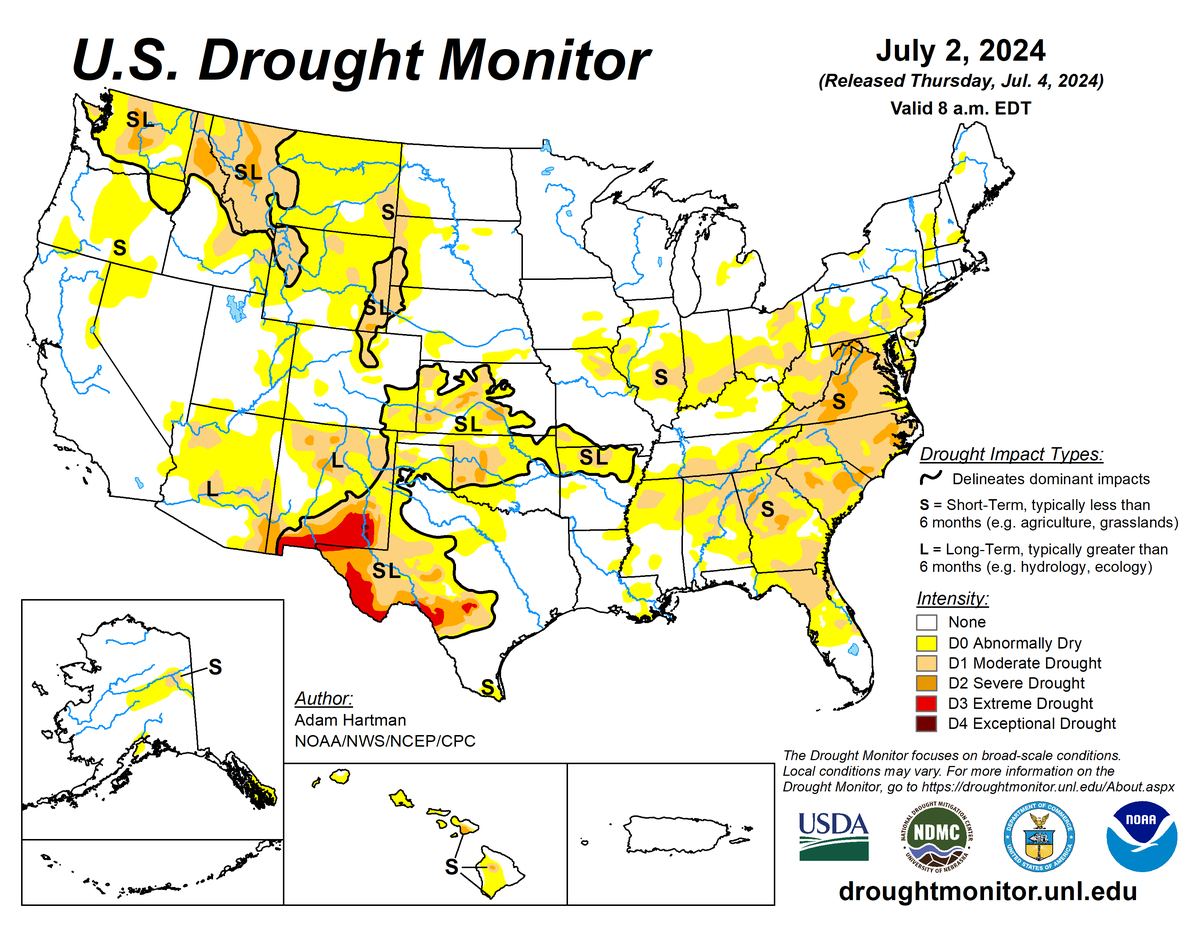
According to the July 2, 2024 U.S. Drought Monitor, moderate to exceptional drought covers 15.8% of the United States including Puerto Rico, an increase from last week’s 13.6%. The worst drought categories (extreme to exceptional drought) increased from 0.6% last week to 0.8%.
A strong ridge of high pressure continued to dominate the upper-level circulation over the southern two-thirds of the contiguous U.S. (CONUS) during this U.S. Drought Monitor (USDM) week (June 26–July 2).
The ridge kept temperatures warmer than normal across most of the West and much of the central and southern Plains to the Southeast and Mid-Atlantic coast. The storm track continued across the U.S.-Canadian border, with surface low-pressure systems bringing areas of rain to the northern states. Cold fronts, which were associated with the surface lows, brought cooler-than-normal weekly temperatures to the northern Plains, Upper Midwest, and interior Northeast. Some of the fronts penetrated into the South, with above-normal precipitation stretching from parts of the central Plains to the Mid-Mississippi Valley and across the coastal Southeast.
Aided by the summer monsoon, some of the fronts and lows gave much of the Southwest a wetter-than-normal week. But other parts of the West, much of the Plains, and large areas east of the Mississippi River had another very dry week. The hot and continued very-dry weather increased evapotranspiration, which dried soils and desiccated crops, especially in the South to Mid-Atlantic regions. An upper-level high-pressure ridge brought warmer- and drier-than-normal weather to Alaska this week and during much of the past month. Trade winds were mostly dry across Hawaii this week. Outer rain bands from Hurricane Beryl brushed Puerto Rico and the U.S. Virgin Islands, resulting in a wetter-than-normal week in the region.
Drought or abnormal dryness contracted where heavier rain fell across parts of the Southwest, central Plains, and Midwest to Northeast. But the continued dryness and heat expanded or intensified drought or abnormal dryness in the Pacific Northwest to the northern High Plains, across parts of the southern Plains, and over much of the Southeast, Ohio Valley, and Mid-Atlantic states, as well as parts of Alaska.
Nationally, expansion was more than contraction, so the nationwide moderate to exceptional drought area percentage increased this week. Abnormal dryness and drought are currently affecting over 141 million people across the United States including Puerto Rico—about 45.4% of the population.

The full U.S. Drought Monitor weekly update is available from Drought.gov
In addition to Drought.gov, you can find further information on the current drought on this week’s Drought Monitor update at the National Drought Mitigation Center
The most recent U.S. Drought Outlook is available from NOAA’s Climate Prediction Center. The U.S. Department of Agriculture’s World Agriculture Outlook Board also provides information about the drought’s influence on crops and livestock
For additional drought information, follow #DroughtMonitor on Facebook and X



